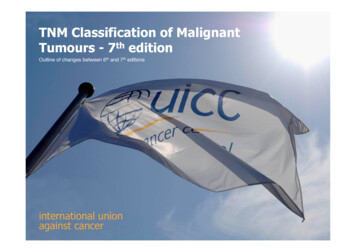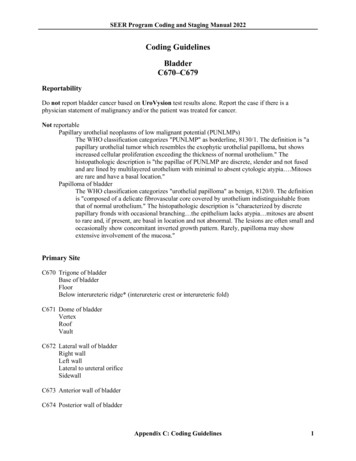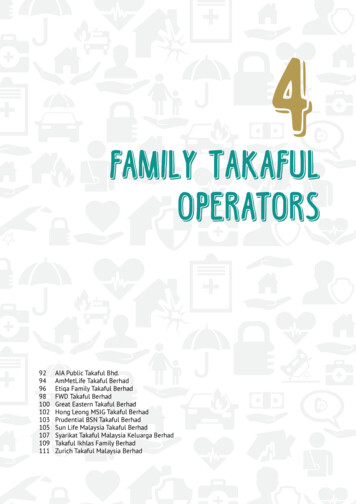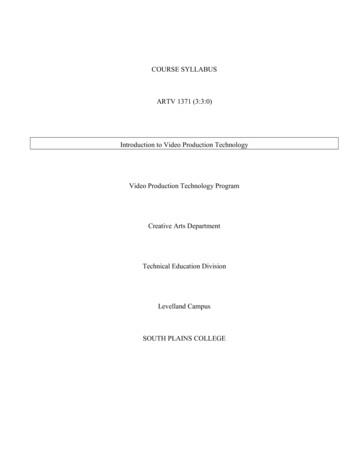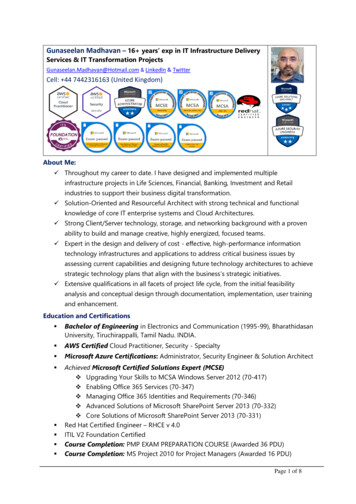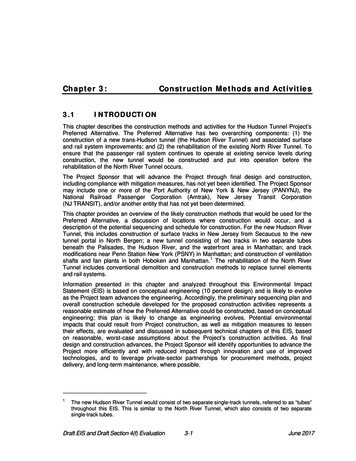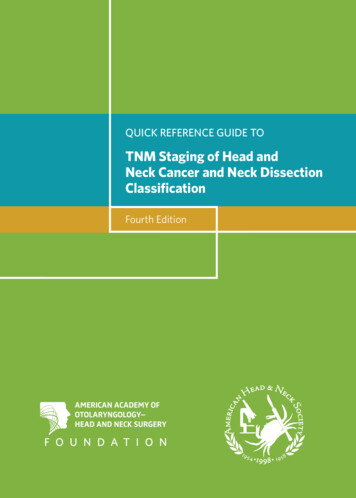
Transcription
QUICK REFERENCE GUIDE TOTNM Staging of Head andNeck Cancer and Neck DissectionClassificationFourth Edition
2014 All materials in this eBook are copyrightedby the American Academy of Otolaryngology—Head and Neck Surgery Foundation, 1650 DiagonalRoad, Alexandria, VA 22314-2857, and the AmericanHead and Neck Society, 11300 W. Olympic Blvd.,Suite 600, Los Angeles CA 90064, and arestrictly prohibited to be used for any purposewithout prior written authorization from theAmerican Academy of Otolaryngology—Head and Neck Surgery Foundation andthe American Head and Neck Society.All rights reserved.For more information, visit ourwebsite at www.entnet.org , or www.ahns.org.eBook Format: Fourth Edition, 2014ISBN: 978-0-615-98874-0Suggested citation: Deschler DG, Moore MG, Smith RV, eds. Quick ReferenceGuide to TNM Staging of Head and Neck Cancer and Neck Dissection Classification,4th ed. Alexandria, VA: American Academy of Otolaryngology–Head and NeckSurgery Foundation, 2014.
Quick Reference Guide toTNM Staging of Head and Neck Cancerand Neck Dissection ClassificationCopublished byAmerican Academy of Otolaryngology—Head and Neck SurgeryAmerican Head and Neck SocietyEdited byDaniel G. Deschler, MDMichael G. Moore, MDRichard V. Smith, MD
Table of ContentsPreface.ivAcknowledgments. vI. Introduction.2A. Upper Aerodigestive Tract Sites.2Oral Cavity . 3Oropharynx . 3Hypopharynx .4Larynx.4Nasopharynx . 6Nasal Cavity and Paranasal Sinuses . 7B. Radiation Therapy and Chemotherapy.7II. American Joint Committee on Cancer (AJCC) TumorStaging by Site .11A. Oral Cavity.11B. Oropharynx. 12C. Larynx. 12D. Hypopharynx.14E. Nasal Cavity and Paranasal Sinuses. 15F. Salivary Glands.16G. Neck Staging under the TNM Staging System for Headand Neck Tumors . 17H. TNM Staging for the Larynx, Oropharynx, Hypopharynx, OralCavity, Salivary Glands, and Paranasal Sinuses.18ii TNM Staging of Head and Neck Cancer and Neck Dissection Classification
III. AJCC Tumor Staging—Nasopharynx, Thyroid,and Mucosal Melanoma.19A. Nasopharynx.19B. Thyroid.20C. Mucosal Melanoma. 23IV. Definition of Lymph Node Groups. 25A. Levels IA and IB: Submental and Submandibular Groups. 25B. Levels IIA and IIB: Upper Jugular Group. 26C. Level III: Middle Jugular Group. 26D. Level IV: Lower Jugular Group. 27E. Levels VA and VB: Posterior Triangle Group. 28F. Level VI: Anterior (Central) Compartment Group. 28V. Conceptual Guidelines for Neck Dissection Classification. 29A. Radical Neck Dissection. 29B. Modified Radical Neck Dissection.30C. Selective Neck Dissection.30D. Extended Radical Neck Dissection. 34www.entnet.org/academyU iii
PrefaceStaging is the language essential to the proper and successful management ofhead and neck cancer patients. It is the core of diagnosis, treatment planning,application of therapeutics from multiple disciplines, recovery, follow-up, andscientific investigation. Staging must be consistent, efficient, accurate, andreproducible. The head and neck cancer caregiver can never be too fluent inthis mode of communication, as we educate patients and navigate themtoward cure. The simple clarification that Stage IV disease is not synonymouswith a “death sentence” has powerful impact for patients and their families.With this imperative, the American Academy of Otolaryngology—Head andNeck Surgery Foundation and the American Head and Neck Society presentthe fourth edition of Quick Reference Guide to TNM Staging of Head and NeckCancer and Neck Dissection Classification.Just as our knowledge of and therapeutics for head and neck cancer evolve,so does the language we use in managing the disease. Such terms as “chemoradiation,” “organ preservation,” “HPV positive,” and “de-escalation” are nowcentral to care planning discussions. Likewise, the staging system evolves toincorporate current knowledge and reflect state-of-the-art treatments.This new edition of Quick Reference Guide to TNM Staging of Head and NeckCancer and Neck Dissection Classification incorporates the changes from theseventh edition of the American Joint Commission on Cancer (AJCC) CancerStaging Manual, as well as updated discussions of site-specific cancers.We hope this Quick Reference Guide will serve the practitioner and the patientequally well as we ready ourselves for further evolution of head and neckcancer staging and management.Daniel G. Deschler, MDCo-editorMichael G. Moore, MDCo-editorRichard V. Smith, MDCo-editoriv TNM Staging of Head and Neck Cancer and Neck Dissection Classification
AcknowledgmentsThe American Academy of Otolaryngology—Head and Neck Surgery and theAmerican Head and Neck Society acknowledge the input from their Head andNeck Surgery Oncology Committee and Head and Neck Surgery EducationCommittees for the review of this publication.All staging information in Chapters II and III are used with the permissionof the American Joint Committee on Cancer (AJCC), Chicago, Illinois. Theoriginal source for this material is the AJCC Cancer Staging Manual, SeventhEdition (2010), published by Springer Science and Business Media LLC,www.springer.com.All photos have been graciously donated by Richard V. Smith, MD.www.entnet.org/academyU v
IV. Definition of Lymph Node GroupsThe level system for describing the location of lymph nodes in the neckconsists of Level I, submental and submandibular group; Level II, upper jugulargroup; Level III, middle jugular group; Level IV, lower jugular group; Level V,posterior triangle group; and Level VI, anterior compartment (Figure 1).A. Levels IA and IB: Submental and Submandibular GroupsIA—SUBMENTAL GROUPLymph nodes within the triangular boundary of the anterior belly of thedigastric muscles and the hyoid bone are at greatest risk for harboringIIIVI IIIIVVFIGURE 1 The level system for describing the location of lymphnodes in the neck: Level I, submental and submandibular group;Level II, upper jugular group; Level III, middle jugular group; LevelIV, lower jugular group; Level V, posterior triangle group; Level VI,anterior compartment.www.entnet.org/academyU 25
metastases from cancers arising from the floor of mouth, anterior oral tongue,anterior mandibular alveolar ridge, and lower lip (Figure 2).IB—SUBMANDIBULAR GROUPThis group consists of lymph nodes within the boundaries of the anterior andposterior bellies of the digastric muscles, the stylohyoid muscle, and the bodyof the mandible. The group includes the pre- and postglandular nodes, andthe pre- and postvascular nodes. The submandibular gland is included in thespecimen when the lymph nodes within this triangle are removed. Thesenodes are at greatest risk for harboring metastases from the cancers arisingfrom the oral cavity, anterior nasal cavity, soft tissue structures of themidface, and submandibular gland (Figure 3).B. Levels IIA and IIB: Upper Jugular GroupThis group is comprised of lymph nodes located around the upper third of theinternal jugular vein and adjacent spinal accessory nerve extending from thelevel of the skull base (above) to the level of the inferior border of the hyoidbone (below). The anterior (medial) boundary is the lateral border of thesternohyoid muscle and the stylohyoid muscle, and the posterior (lateral)boundary is the posterior border of the sternocleidomastoid muscle. SublevelIIA nodes are located anterior (medial) to the vertical plane defined by thespinal accessory nerve. Sublevel IIB nodes are located posterior (lateral) tothe vertical plane defined by the spinal accessory nerve. The upper jugularnodes are at greatest risk for harboring metastases from cancers arising fromthe oral cavity, nasal cavity, nasopharynx, oropharynx, hypopharynx, larynx,and parotid gland (Figure 3).C. Level III: Middle Jugular GroupThis group consists of lymph nodes located around the middle third of theinternal jugular vein extending from the inferior border of the hyoid bone(above) to the inferior border of the cricoid cartilage (below). The anterior(medial) boundary is the lateral border of the sternohyoid muscle, and theposterior (lateral) boundary is the posterior border of the sternocleidomastoid muscle. (Included in this group is the jugulo-omohyoid node, which liesimmediately above the superior belly of the omohyoid muscle as it crossesthe internal jugular vein.) These nodes are at greatest risk for harboring26 TNM Staging of Head and Neck Cancer and Neck Dissection Classification
FIGURE 2Dark lines depict the boundaries ofthe submental (IA) and anteriorcompartment (VI) lymph nodes.IAVIIAIBIIBIIAIIIVAFIGURE 3The boundaries dividing levels I, II,and V into sublevels A and B.IV VBmetastases from cancers arising from the oral cavity, nasopharynx, oropharynx, hypopharynx, and larynx (Figure 3).D. Level IV: Lower Jugular GroupThis group consists of lymph nodes located around the lower third of theinternal jugular vein extending from the inferior border of the cricoid (above)to the clavicle (below). The anterior (medial) boundary is the lateral border ofthe sternohyoid muscle, and the posterior (lateral) boundary is the posteriorwww.entnet.org/academyU 27
border of the sternocleidomastoid muscle. These nodes are at greatest riskfor harboring metastases from cancers arising from the hypopharynx, cervicalesophagus, and larynx (Figure 3).E. Levels VA and VB: Posterior Triangle GroupThis group is comprised predominantly of the lymph nodes located along thelower half of the spinal accessory nerve and the transverse cervical artery,along with the supraclavicular nodes. The superior boundary is the apexformed by a convergence of the sternocleidomastoid and the trapeziusmuscles, the inferior boundary is the clavicle, the anterior (medial) boundaryis the posterior border of the sternocleidomastoid muscle, and the posterior(lateral) boundary is the anterior border of the trapezius muscle. Sublevel VAis separated from Sublevel VB by a horizontal plane marking the inferiorborder of the arch of the cricoid cartilage. Sublevel VA includes the spinalaccessory nodes, and Sublevel VB includes the nodes following the transversecervical vessels and the supraclavicular nodes. (Virchow’s node is located inLevel IV.) The posterior triangle nodes are at greatest risk for harboringmetastases from cancers arising from the nasopharynx and oropharynx(Sublevel VA), and the thyroid gland (Sublevel VB) (Figure 3).The surgical landmark that defines the lateral boundary of Levels II, III, and IVand the corresponding medial boundary of the posterior triangle (Level V) isthe plane that parallels the sensory branches of the cervical plexus.F. Level VI: Anterior (Central) Compartment GroupLymph nodes in this compartment include the pre- and paratracheal nodes,the precricoid (Delphian) node, and the perithyroidal nodes, including thelymph nodes along the recurrent laryngeal nerves. The superior boundary isthe hyoid bone, the inferior boundary is the suprasternal notch, and the lateralboundaries are the common carotid arteries. These nodes are at greatest riskfor harboring metastases from cancers arising from the thyroid gland, glotticand subglottic larynx, apex of the pyriform sinus, and cervical esophagus(Figure 2).28 TNM Staging of Head and Neck Cancer and Neck Dissection Classification
The American Academy of Otolaryngology—Head and Neck SurgeryFoundation’s education initiatives are aimed at increasing the quality ofpatient outcomes through knowledgeable, competent, and professionalphysicians. The goals of education are to provide activities and services forpracticing otolaryngologists, physicians-in-training, and nonotolaryngologisthealth professionals.The Foundation’s AcademyU serves as the primary education resourcefor otolaryngology–head and neck surgery activities and events. Theseinclude expert-developed knowledge resources, subscription products, liveevents, eBooks, and online education. In addition, the AAO-HNSF AnnualMeeting & OTO EXPOSM is the world’s largest gathering of otolaryngologists,offering a variety of education seminars, courses, and posters. Many ofthe Foundation’s activities are available for AMA PRA Category 1 Credit .Visit www.entnet.org/academyu to find out how AcademyU can assist youand your practice through quality professional development opportunities.AHNS MISSIONOn May 13, 1998, The American Head and Neck Society (AHNS) became thesingle largest organization in North America for the advancement of researchand education in head and neck oncology. The merger of two societies, theAmerican Society for Head and Neck Surgery and the Society of Head andNeck Surgeons, formed the American Head and Neck Society. The AmericanHead and Neck Society remains dedicated to the common goals of itsparental organizations: To promote and advance the knowledge of prevention, diagnosis,treatment, and rehabilitation of neoplasms and other diseases of thehead and neck, To promote and advance research in diseases of the head and neck, and To promote and advance the highest professional and ethical standards.For more information about the AHNS, visit www.ahns.info.
American Academy ofOtolaryngology—Head andNeck Surgery Foundation1650 Diagonal RoadAlexandria, VA 22314-2857The American Head andNeck Society (AHNS)11300 W. Olympic Blvd.,Suite 600Los Angeles CA 90064Phone: 1.703.836.4444Fax: 1.703.683.5100Web: www.entnet.orgPhone: 1.310.437.0559Fax: 1.310.437.0585Email: admin@ahns.infoWeb: www.ahns.info
Level II, upper jugular group; Level III, middle jugular group; Level . soft tissue structures of the midface, and submandibular gland (Figure 3). B. Levels IIA and IIB: Upper Jugular Group . single largest organization in North America for the advancement of research and education in head and neck oncology. The merger of two societies, the
